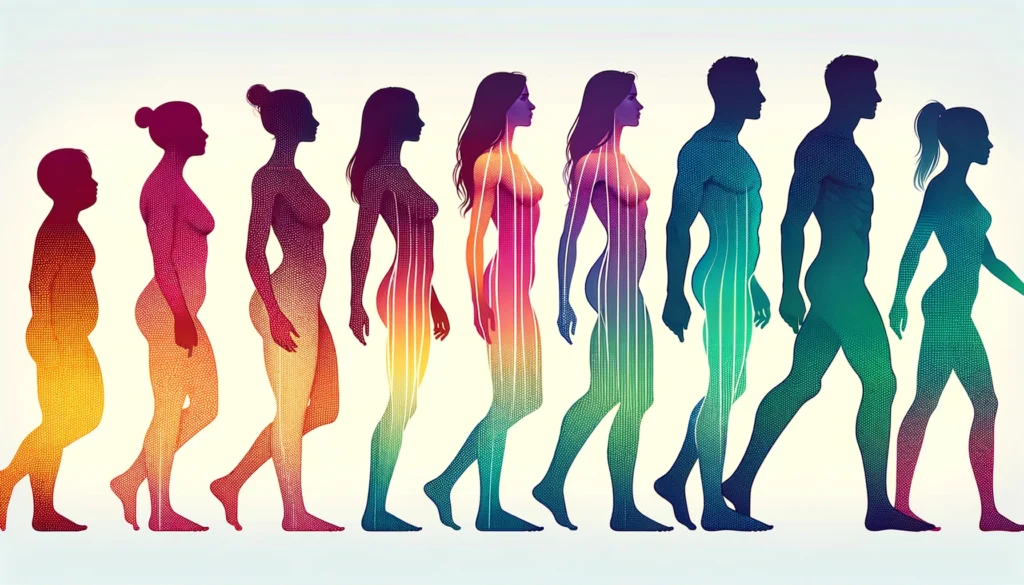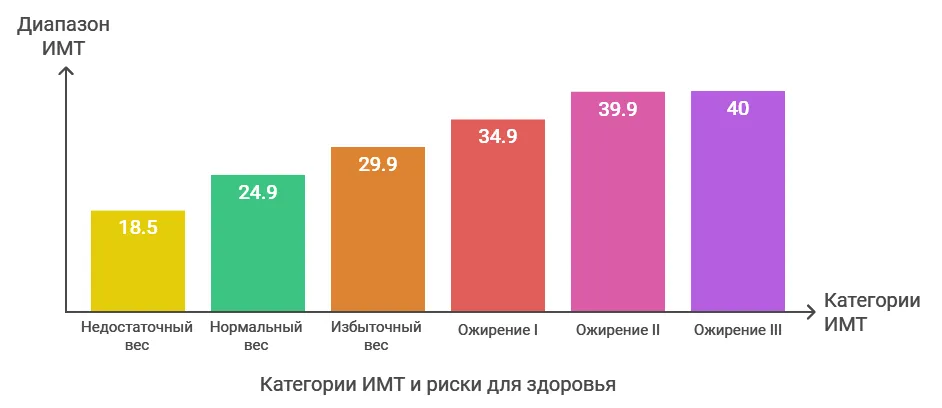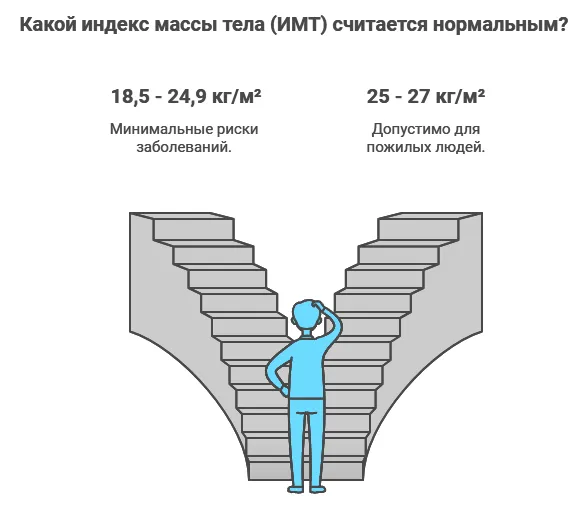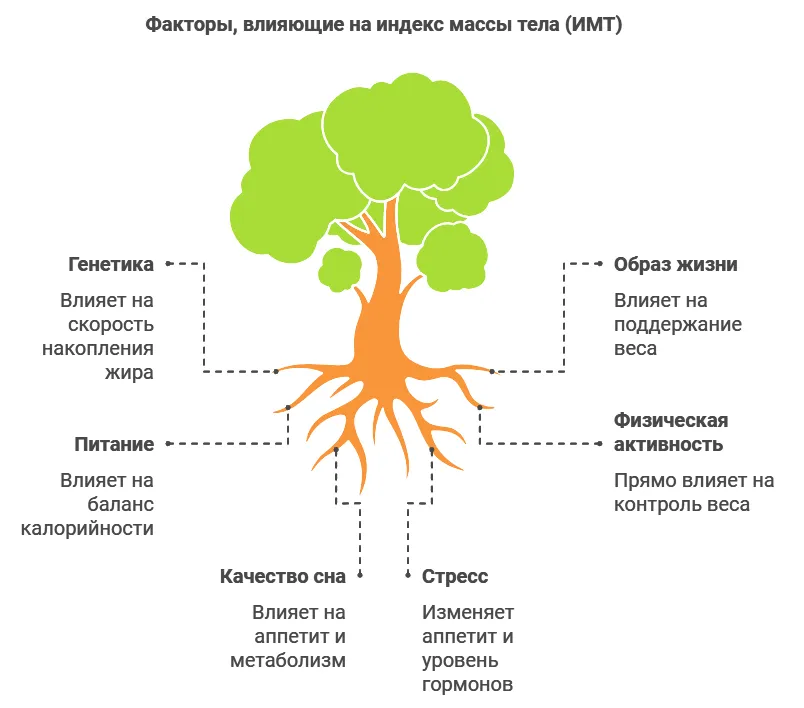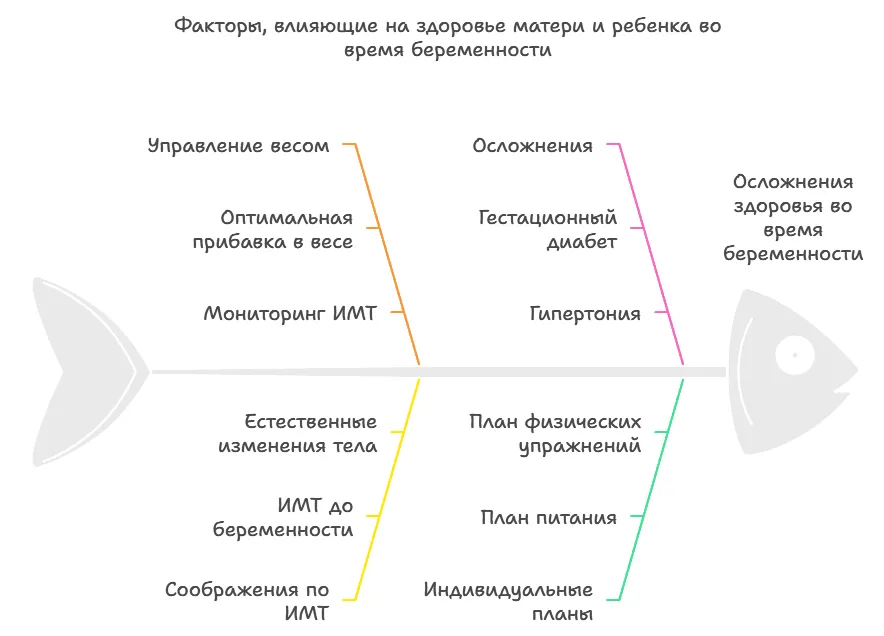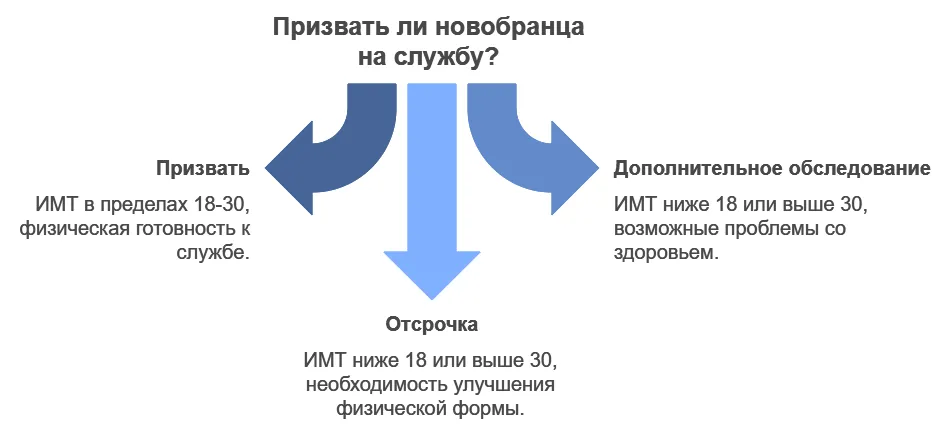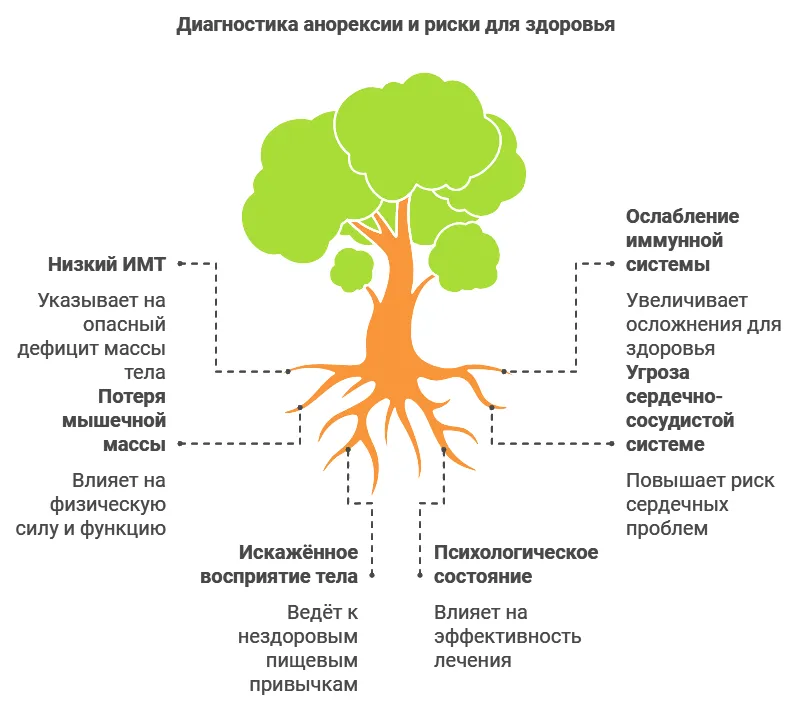Calculate your body mass index (BMI) with our handy calculator. Find out if your weight is normal and get personalized recommendations on diet and physical activity to achieve your desired results.
Введите ваш вес (1–300 кг).
Введите ваш рост (50–250 см).
Введите ваш возраст (1–120 лет).
Выберите, насколько вы активны в течение дня.
Table of contents
Hello, we would like to ask you to help us improve this calculator. If you have noticed any bugs or found out that we should add or, on the contrary, remove some features, please write about it. Your opinion is very important for further development of this tool!
Want to know your Body Mass Index (BMI) and understand how your body responds to physical activity, age and gender? My calculator is simply an indispensable tool that will give you accurate data about your condition and help you make informed decisions to improve your health.
With this calculator, you can quickly calculate your BMI and get personalized recommendations based on real data. By entering your weight, height, age, gender and activity level, you'll get not only your BMI, but also several other useful metrics such as body fat percentage and baseline metabolic rate. All of this will help you understand how balanced your lifestyle is and where you should make adjustments.
The results will tell you which category you are in - underweight, normal weight, overweight or obese. And based on this data, I will give you useful advice on what you should change in your diet, what level of physical activity you need, and how to improve your overall body tone.
This calculator is more than just numbers. It is your trusted assistant on the road to health. Whether you're looking to stay in shape or gain mass, you'll get accurate recommendations so you can take the right step in the right direction. Don't miss the opportunity to find out what these numbers say about your body and start taking action today!
Try my calculator and not only will you know your BMI, but you'll get a clear picture of how you can improve your health, energy levels and well-being.
Instructions for filling out the BMI calculator form
To use the BMI (body mass index) calculator and recommendations for better health, it's important to fill out the form correctly. Here are detailed instructions to help you do this:
Weight (kg)
This field is for entering your current weight in kilograms. Enter your exact weight, using decimals for a more accurate calculation if necessary. For example, if your weight is 70.5 kilograms, enter "70.5".
Height (cm)
Here you must enter your height in centimeters. It is important to enter your full height without rounding. If your height is 172.3 centimeters, enter "172".
Age
Enter your current age in full years. This parameter is used to adjust the BMI calculation because weight changes with age. For example, if you are 30 years old, enter "30".
Paul
Select your gender from the options offered ("Male" or "Female"). This option also affects the calculation of BMI, as men and women have different body weight distributions.
Activity level
Choose your level of daily physical activity from the options provided. This will help tailor the recommendations to your lifestyle. Options include "Minimal activity", "Light activity", "Moderate activity", "Active lifestyle" and "Extreme activity". Rate your activity based on your normal daily routine.
Calculating BMI
After filling in all the fields, click the "Calculate BMI" button. You will be presented with the results of the calculation, including your BMI and its interpretation, comparison with your ideal BMI, and personalized recommendations.
Important points:
- Data Accuracy: the more accurately you enter your data, the more accurate the calculation will be.
- Data Validation: make sure that all figures are entered correctly, especially weight and height.
- Confidentiality: The data entered is processed directly in your browser and is not sent anywhere, ensuring your privacy.
Пользуясь этим калькулятором, вы можете получить представление о своем ИМТ и рекомендации для поддержания или достижения здорового веса. Однако помните, что он не заменяет профессиональную медицинскую консультацию.
Useful materials on BMI
What is BMI?
Body Mass Index (BMI) is a measure that is calculated as weight (in kg) divided by the square of height (in m²). It is used to determine whether a person's weight is normal. Doctors, trainers and nutritionists often use BMI as a simple way to make an initial assessment of health risks, including cardiovascular disease and diabetes, associated with being overweight or underweight. That said, BMI does not measure fat levels directly, so it is recommended to supplement it with fat mass analysis and waist circumference measurements for a more accurate assessment of health.
Классификация ИМТ по ВОЗ
Всемирная организация здравоохранения (ВОЗ) разработала международную классификацию ИМТ для взрослых, которая служит стандартом для оценки массы тела и связанных рисков для здоровья. ВОЗ выделяет следующие категории:
- Underweight: менее 18,5 кг/м² — повышенный риск дефицита питательных веществ и ослабления иммунитета.
- Normal weight: 18,5–24,9 кг/м² — оптимальный уровень, связанный с минимальным риском для здоровья.
- Overweight: 25–29,9 кг/м² — повышенный риск сердечно-сосудистых заболеваний и диабета.
- Grade I obesity: 30–34,9 кг/м² — значительный риск для здоровья, включая сердечно-сосудистые заболевания, диабет и проблемы с суставами.
- Grade II obesity: 35–39,9 кг/м² — серьезное повышение рисков, требующее медицинского вмешательства.
- Ожирение III степени (тяжелое ожирение): 40 и более кг/м² — крайне высокий риск, требующий комплексного лечения.
Эти категории помогают специалистам оценить состояние пациента и определить необходимость вмешательства. Важно помнить, что ИМТ — не единственный показатель здоровья; врачи также учитывают процент жира в организме, окружность талии и общее состояние здоровья.
Норма ИМТ
Нормальный индекс массы тела для взрослого человека составляет от 18,5 до 24,9 кг/м². Этот диапазон считается безопасным для здоровья, так как он связан с минимальными рисками развития таких хронических заболеваний, как сердечно-сосудистые болезни и диабет 2 типа. Однако нормальные значения могут варьироваться в зависимости от возраста, пола и уровня физической подготовки. Например, пожилым людям допускается более высокий ИМТ (до 25–27 кг/м²), поскольку у них естественно снижается мышечная масса. Индивидуальные особенности также играют роль, поэтому полезно обсудить свои показатели с врачом для более точной оценки.
Факторы, влияющие на ИМТ
На индекс массы тела (ИМТ) влияют генетика, образ жизни, питание, уровень физической активности, качество сна и даже стресс. Генетическая предрасположенность может ускорить или замедлить накопление жировой ткани, что отражается на весе и телосложении. Питание — особенно калорийность и баланс нутриентов — и физическая активность напрямую влияют на поддержание нормального веса. Качественный сон также важен, поскольку его недостаток может привести к повышенному аппетиту и замедленному метаболизму. Стресс, в свою очередь, может воздействовать на аппетит и вызывать гормональные изменения, способствующие набору веса. Осознанное управление этими факторами не только помогает поддерживать ИМТ в здоровом диапазоне, но и положительно влияет на общее состояние здоровья.
Формула ИМТ
Индекс массы тела (ИМТ) рассчитывается по простой формуле: вес (в кг) делится на квадрат роста (в м). Например, у человека с весом 70 кг и ростом 1,75 м ИМТ равен 70 / (1,75²) = 22,86 кг/м². Полученный показатель можно сопоставить с таблицей ИМТ, чтобы определить категорию массы тела, что помогает оценить потенциальные риски для здоровья. Однако следует помнить, что ИМТ — это лишь ориентир, который не учитывает такие факторы, как мышечная масса и возраст. Для более точной оценки здоровья рекомендуется использовать дополнительные методы, например, анализ процента жира в организме.
Чтобы рассчитать свой ИМТ, можно использовать формулу:
ИМТ=вес (кг)рост (м)2\text{ИМТ} = \frac{\text{вес (кг)}}{\text{рост (м)}^2}BMI=рост (м)2вес (кг)
Например, человек весом 70 кг и ростом 1.75 м будет иметь ИМТ:
ИМТ=701.752=22.9\text{ИМТ} = \frac{70}{1.75^2} = 22.9BMI=1.75270=22.9
В этом случае результат попадает в категорию «Нормальная масса тела».
BMI table
Таблица ИМТ делит показатели на несколько категорий, принятых Всемирной организацией здравоохранения (ВОЗ): недостаточный вес (менее 18,5), нормальный вес (18,5–24,9), избыточный вес (25–29,9) и ожирение (от 30 и выше). Эта классификация позволяет врачам и пациентам быстро оценить, находится ли вес в зоне риска для здоровья. Важно помнить, что ИМТ — это только ориентировочный показатель, который не учитывает различия в мышечной массе, возрасте или типе телосложения. Если ваш ИМТ выходит за пределы нормы, это сигнал к более детальному анализу здоровья и, возможно, пересмотру питания и физической активности.
| Category | BMI (kg/m²) |
|---|
| Недостаточная масса тела | Менее 18.5 |
| Нормальная масса тела | 18.5 – 24.9 |
| Избыточная масса тела | 25.0 – 29.9 |
| Grade I obesity | 30.0 – 34.9 |
| Grade II obesity | 35.0 – 39.9 |
| Grade III obesity | 40.0 и более |
Нормальный ИМТ
Поддержание ИМТ в пределах 18,5–24,9 кг/м² помогает снизить нагрузку на суставы, улучшает обмен веществ, поддерживает сердечно-сосудистое здоровье и снижает риск хронических заболеваний, таких как диабет, гипертония и повышенный уровень холестерина. Важно помнить, что нормальный ИМТ — это не только про вес, но и про общее состояние организма. Однако каждый организм индивидуален, и значение ИМТ может варьироваться в зависимости от возраста, мышечной массы и других факторов. Сосредоточьтесь на здоровом питании и активном образе жизни, чтобы сохранить баланс между ростом и массой тела.
Степени ожирения по ИМТ
Ожирение классифицируется на три степени: первая (ИМТ 30–34,9), вторая (35–39,9) и третья (40 и выше). Каждая степень повышает риск различных заболеваний, включая сердечно-сосудистые заболевания, диабет, гипертонию и проблемы с суставами. Эта классификация позволяет врачам оценить уровень риска для здоровья и выбрать наиболее подходящие меры для снижения веса: изменения в питании, повышение физической активности, а в некоторых случаях — медикаментозное лечение. Важно помнить, что степень ожирения — это ориентир, и врачи учитывают дополнительные факторы, такие как возраст, состояние здоровья и образ жизни пациента. Чем выше степень ожирения, тем более необходимы комплексные меры для снижения веса и укрепления здоровья.
Как высчитать ИМТ
Для расчёта индекса массы тела (ИМТ) возьмите вес в килограммах и разделите его на квадрат роста в метрах. Например, если вес составляет 65 кг, а рост — 1,68 м, то расчёт будет: 65 / (1,68²) = 23,03 кг/м². Показатель в пределах 18,5–24,9 кг/м² считается нормальным и обычно свидетельствует о низком риске для здоровья. Однако ИМТ не учитывает состав тела, например, соотношение мышечной и жировой массы, поэтому его результаты следует интерпретировать с осторожностью. Рекомендуется обсудить показатели ИМТ с врачом для более комплексной оценки здоровья.
ИМТ при беременности
Во время беременности рекомендуется следить за изменением ИМТ, чтобы поддерживать здоровье матери и ребёнка. ИМТ перед беременностью помогает определить оптимальную прибавку веса на разных этапах: для женщин с нормальным ИМТ она обычно составляет от 11 до 16 кг за всю беременность. Это важно для предотвращения осложнений, таких как гестационный диабет и гипертония. Следует помнить, что ИМТ во время беременности — это ориентировочный показатель, поскольку тело претерпевает естественные изменения, включая увеличение объёма крови и рост плода. Будущие мамы могут обсудить с врачом свои показатели ИМТ и подобрать индивидуальный план питания и физической активности для поддержания здоровья.
ИМТ код по МКБ-10 у взрослых
В Международной классификации болезней (МКБ-10) индекс массы тела (ИМТ) кодируется по разным категориям массы тела: недостаточный вес (Z68.3), нормальный вес (Z68.1), избыточный вес (Z68.2), ожирение (Z68.4). Коды из раздела «Z68» используются для документирования состояния, связанного с массой тела, в медицинских записях. Они помогают врачам отслеживать изменения веса пациента, анализировать статистику заболеваемости, а также могут применяться в страховых расчётах и других аспектах медицинской документации. Эти коды особенно важны при назначении лечения и профилактических мер для пациентов с нарушениями массы тела.
Сколько процентов россиян имеют ИМТ выше 25
Согласно последним исследованиям, более 60% россиян имеют ИМТ выше 25, что свидетельствует о тенденции к избыточному весу и ожирению. Этот показатель отражает глобальную тенденцию роста избыточной массы тела, что вызывает обеспокоенность среди специалистов в области здравоохранения. Избыточный вес связан с повышенным риском сердечно-сосудистых заболеваний, диабета и других хронических болезней. Поддержание ИМТ в норме может существенно снизить эти риски, способствуя улучшению качества жизни и снижению нагрузки на систему здравоохранения.
С каким ИМТ не берут в армию
Для службы в армии установлены строгие нормы ИМТ, которые обычно находятся в пределах от 18 до 30. Эти границы помогают убедиться, что новобранец физически готов к нагрузкам, связанным со службой. Отклонение от нормы может свидетельствовать о проблемах с физическим состоянием, которые могут повлиять на выносливость и работоспособность. Призывники с ИМТ ниже 18 или выше 30 часто направляются на дополнительное медицинское обследование или могут получить отсрочку для улучшения физической формы. Следует учитывать, что требования ИМТ могут незначительно различаться в зависимости от рода войск и состояния здоровья призывника.
При каком ИМТ анорексия
Анорексия у взрослых обычно диагностируется при ИМТ ниже 17,5, что указывает на опасный дефицит массы тела. Такой низкий показатель сопровождается серьёзными рисками для здоровья, включая ослабление иммунной системы, потерю мышечной массы и угрозу для сердечно-сосудистой системы. Однако ИМТ — это лишь один из критериев диагностики анорексии; врачи также оценивают клинические симптомы, такие как искажённое восприятие тела, сильное ограничение в питании и психологическое состояние пациента. Раннее вмешательство и комплексное лечение могут существенно повысить шансы на успешное восстановление и поддержание здоровья.
Определить риск заболеваний по ИМТ
Индекс массы тела (ИМТ) — один из индикаторов риска для здоровья. Люди с ИМТ выше 25 подвержены повышенному риску сердечно-сосудистых заболеваний, диабета, гипертонии и некоторых видов рака. Степень риска зависит от категории ИМТ: избыточный вес (25–29,9) связан с умеренным риском, а ожирение (30 и выше) — с высоким. Поддержание ИМТ в норме (18,5–24,9) может существенно снизить эти риски. Однако стоит помнить, что ИМТ — это ориентировочный показатель, который не учитывает состав тела. Для более точной оценки состояния здоровья рекомендуется проконсультироваться с врачом. Если ваш ИМТ выходит за пределы нормы, рассмотрите возможность изменения рациона и уровня физической активности для улучшения показателей здоровья.
Research and verification of BMI calculator
The text in this calculator with facts and conclusions is verified through - Fact Checker
 SAS tools Website with 1000s of useful SAS tools and calculators
SAS tools Website with 1000s of useful SAS tools and calculators 